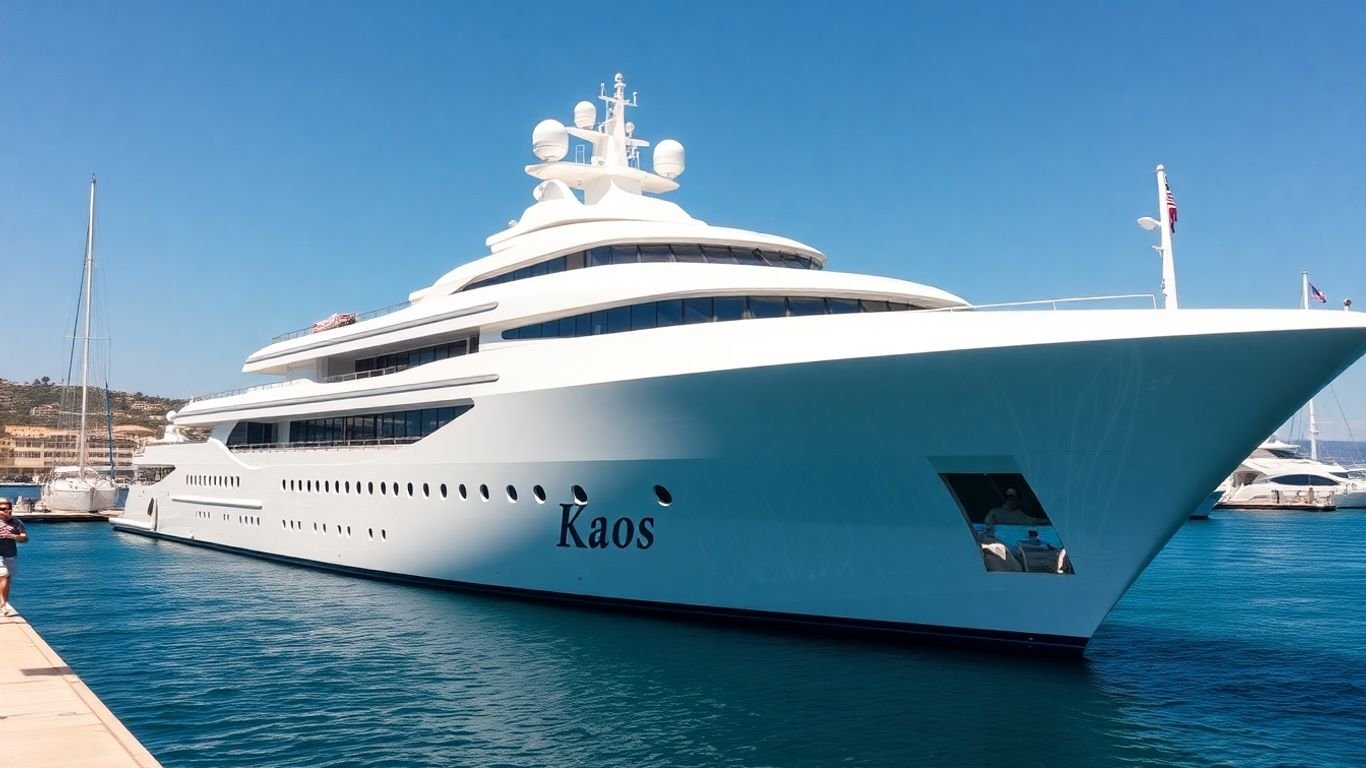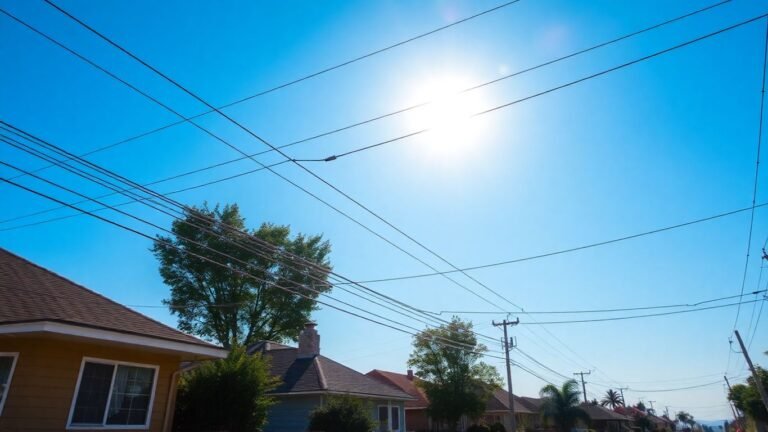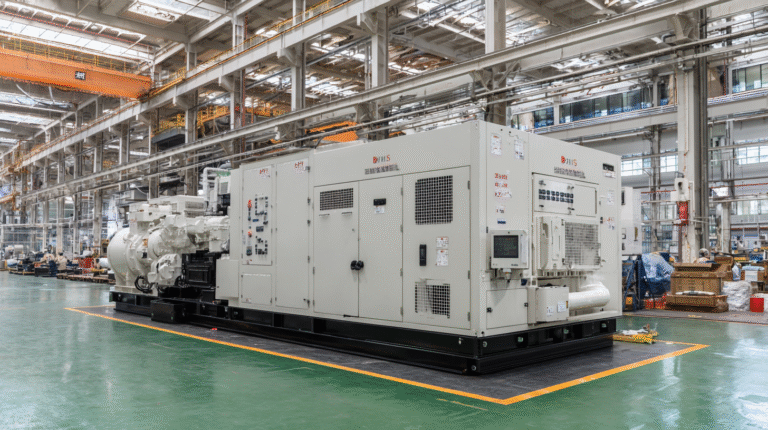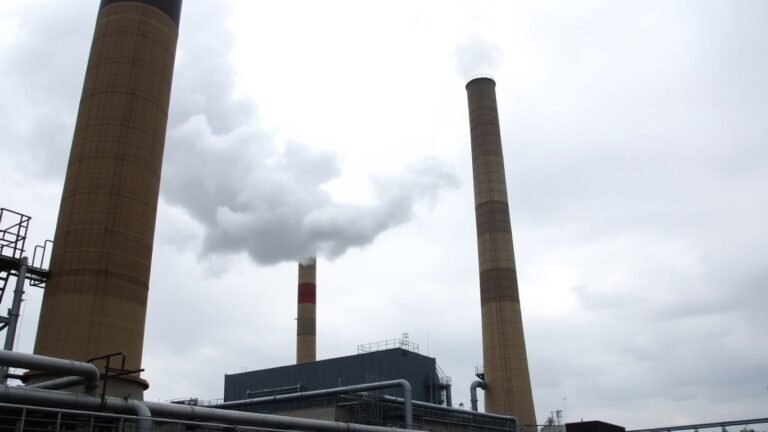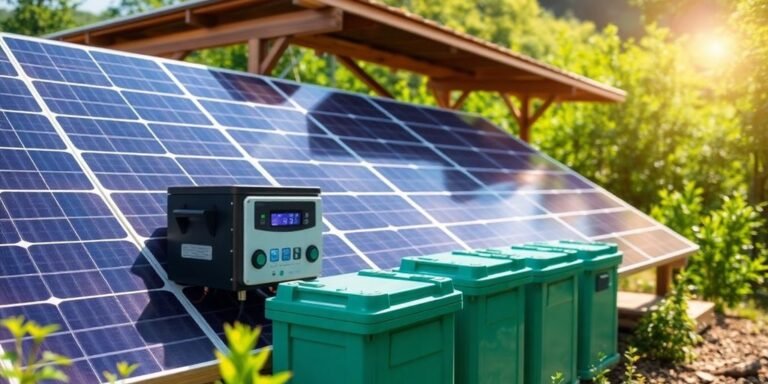Superyacht Kaos: An In-Depth Look at Its Massive Energy Consumption
So, this massive superyacht called Kaos, owned by a Walmart heiress, is just sitting there in Spain. It’s super hot, so they’re running the air conditioning all the time. And get this – it’s using enough electricity and energy every day to power about 250 average American homes. Even when nobody’s even on board! It really makes you think about the massive energy demands these floating palaces need, just to stay comfortable.
Key Takeaways
- The $300 million superyacht Kaos, docked in Spain, consumes a huge amount of electricity daily.
- Its daily power usage is equivalent to what 250 American homes would use in a day.
- Air conditioning systems are a major energy drain, running non-stop to combat the heat and humidity.
- Beyond cooling, numerous other systems like water production, leisure amenities, and technology add to the yacht’s constant power demand.
- Even when idle, the yacht’s energy consumption is substantial, highlighting the immense power needs of luxury vessels.
Superyacht’s Staggering Daily Energy Consumption
It’s pretty wild to think about, but this massive $300 million superyacht, the Kaos, is basically running like a small town when it comes to power. Even when no one’s actually on board, just sitting there docked in Spain, it’s using a mind-boggling amount of electricity. We’re talking enough power each day to keep about 250 average American homes humming along. It really puts into perspective the sheer scale of luxury and the energy demands that come with it.
Daily Electricity Usage Equivalent to Hundreds of Homes
The numbers are pretty eye-opening. Calculations suggest the Kaos burns through roughly 7.2 megawatt-hours of electricity every single day. To put that into perspective, that’s enough to power around 250 American homes for 24 hours straight. This isn’t even when the yacht is cruising or hosting a big party; this is just the baseline consumption while it’s docked and essentially idling. It’s a constant draw, keeping all the essential systems ticking over.
The True Cost of Luxury at Sea
Beyond the initial purchase price of $300 million, the operational costs are just as immense. The daily electricity bill alone for this level of comfort can run into thousands of dollars. This constant energy drain is a significant part of maintaining a vessel of this caliber, highlighting that the price of owning such a luxury item extends far beyond the sticker price. It’s a continuous investment just to keep the ship ready and comfortable.
Understanding the Scale of Superyacht Power Needs
Superyachts are essentially floating palaces, and they require a power infrastructure to match. Think about all the systems that need to run: climate control, water makers, lighting, entertainment, and all the complex machinery keeping everything operational. It’s not just about powering a few lights; it’s about maintaining a comfortable environment and running sophisticated equipment 24/7. This requires a robust power generation setup, often involving powerful offshore generators that can handle these substantial loads.
The energy consumption of a superyacht like the Kaos, even when stationary, is a stark reminder of the immense resources required to maintain such a high level of luxury and comfort. It’s a world away from the energy usage of an average household.
Here’s a quick look at what contributes to this massive draw:
- Climate Control: Keeping the interior at a comfortable temperature, especially in hot climates like Spain, is a huge energy consumer.
- Water Systems: Desalination plants and other water management systems require significant power.
- Leisure Amenities: Pools, spas, and entertainment systems add to the continuous energy demand.
- Crew and Guest Comfort: Lighting, ventilation, and basic operational needs for the crew also factor in.
Constant Power Demands of a Luxury Vessel

Even when the owner isn’t aboard, a superyacht like the Kaos is essentially a floating city, and cities need power. This means a lot of systems are running all the time, not just for comfort but for basic operation. Think of it like leaving the lights and refrigerator on at home, but on a much, much grander scale.
Essential Systems Running Non-Stop
There are core functions that simply can’t be switched off. These are the backbone of keeping a vessel of this size operational and safe.
- Bilge Pumping: Removing unwanted water from the hull.
- Firefighting Systems: Ready for any emergency.
- Fuel Polishing: Keeping the fuel clean and usable.
- Sewage Treatment: Managing waste responsibly.
These systems, even when not actively engaged, require a baseline power draw to remain in standby mode, ready to function instantly. Engineers estimate this constant load can be around 10 to 25 kW, which is already a significant amount of electricity.
Crew Comfort and Operational Needs
Keeping a crew of 45 people comfortable and able to do their jobs requires a lot of energy. This isn’t just about keeping them cool; it’s about powering the equipment they use daily.
- Lighting: Even with efficient LEDs, the sheer number of spaces needing illumination adds up.
- Ventilation: Ensuring fresh air circulation throughout the vessel.
- Communication Systems: Keeping the crew connected internally and externally.
This continuous operational demand is a major factor in the yacht’s overall energy footprint. It’s a constant hum of activity that powers the unseen work keeping the Kaos running smoothly.
The Energy Footprint of Advanced Technology
Modern superyachts are packed with sophisticated technology, and all of it needs power. From entertainment systems to navigation, these components are always drawing electricity.
- AV Racks and Servers: These systems, often running for entertainment or operational data, require constant power and cooling.
- Satellite Communication Domes: Keeping the yacht connected to the outside world, even when far from shore.
- CCTV Systems: Security cameras and their monitoring equipment are always on.
These technological demands, while perhaps less obvious than air conditioning, contribute significantly to the yacht’s overall power consumption. It’s a hidden energy drain that’s become standard on vessels of this caliber, reflecting the luxury and connectivity expected by owners and guests. The integration of such advanced systems means that even when the yacht is docked, it’s still a significant consumer of power, much like a high-tech data center. This constant draw is a key reason why superyachts are often compared to small towns in terms of their energy needs, requiring robust power solutions that can handle continuous loads, similar to those found in industrial applications or on offshore oil rigs.
The sheer amount of cabling alone on a yacht of this size, potentially hundreds of miles, hints at the complexity and the constant electrical pathways required to keep everything functioning. It’s a testament to the engineering involved, but also a stark reminder of the energy required to maintain such a sophisticated environment.
Climate Control: A Major Energy Drain
Air Conditioning’s Relentless Operation
When a superyacht like the Kaos is docked in a warm place like Spain, keeping things cool is a huge job. The air conditioning system basically runs all the time, even when no one is on board. Think about it – you wouldn’t leave your home AC blasting 24/7, but on a yacht this size, it’s a different story. It’s not just about making it comfortable for guests; it’s about protecting all the fancy stuff inside from heat damage too. Engineers figure the AC alone can pull around 150 to 220 kilowatts on a hot day, and that’s just for the cooling part.
Dehumidification Cycles in Humid Climates
Besides just cooling the air, these yachts have to deal with humidity. When doors open to the dock, especially in a place like Málaga, humid air rushes in. The yacht’s systems then have to work overtime to pull that moisture out of the air. This constant battle against dampness adds a significant load to the power systems. It’s like having a second job for the AC, just to keep the air from feeling sticky and damp, which can also damage the luxurious interiors over time.
Maintaining Set Temperatures Around the Clock
Even when the yacht is sitting idle, the crew needs to keep the interior at a specific temperature. This is especially true for guest areas and cabins before anyone arrives. So, the cooling systems are programmed to maintain these exact temperatures, day and night. It’s a continuous process, a steady hum of energy consumption just to be ready for when people step aboard. This constant, low-level operation adds up significantly over hours and days, contributing to the massive overall energy use.
The sheer scale of a superyacht means that even basic comfort systems, like air conditioning, require power levels that are hard to grasp. It’s a constant demand, a background hum of electricity usage that never really stops, all to maintain a perfect environment within the vessel’s hull.
Beyond Air Conditioning: Additional Power Consumers
While keeping things cool is a huge part of the energy bill, it’s far from the only thing sucking up power on a vessel like the Kaos. Think about all the other systems that need to run, day in and day out, just to keep this floating palace functioning.
Water Systems and Desalination Loads
Keeping a superyacht supplied with fresh water is a massive undertaking. The reverse-osmosis desalination units, which are basically high-tech water makers, need serious juice. Their high-pressure pumps alone can draw between 18 and 37 kW. Then you’ve got booster motors adding another 5 kW on top of that. Even when the yacht isn’t actively making water at sea, topping up supplies in port is common. When you factor in sewage treatment, bilge pumps, fuel polishing, and the fire-fighting systems, you’re looking at a constant load of about 10 to 25 kW, even when the yacht is just sitting there.
Leisure Amenities Requiring Continuous Power
All those fancy amenities don’t run on wishes and dreams. The Kaos boasts a large pool, complete with an aquarium wall, plus spa tubs and a hammam. Just keeping the water circulating, heated, or cooled to the right temperature, and filtered, adds a significant power demand. We’re talking an extra 10 to 30 kW, depending on how much the water is being used and what temperature it needs to be. While some systems can recapture waste heat, maintaining these luxurious water features still requires a steady stream of electricity.
Galley and Laundry Operations
Feeding 31 guests and 45 crew members means the yacht’s galleys operate like a high-end restaurant kitchen, 24/7. Multiple ovens, induction cooktops, professional dishwashers, blast chillers, and industrial ice makers are all running daily. Commercial dishwashers, for instance, can use around 1 kWh per cycle, and they get used a lot during meal times. Then there’s the laundry. Professional-grade washers and dryers for both guest and crew linens add another consistent drain, especially during guest changes or busy cruises. All these service areas combined can easily average 25 to 50 kW throughout the day, with spikes much higher during peak meal hours. It’s a lot of power just to keep everyone fed and their towels clean.
The sheer scale of operations on a superyacht means that even systems not directly related to guest comfort, like water production and waste management, contribute substantially to the overall energy consumption. These are not optional luxuries but operational necessities that demand significant, continuous power.
It’s pretty wild to think about the amount of electricity needed for everything from making water to cooking meals. These systems, often overlooked, are a big reason why these yachts have such a massive energy footprint. They’re not just about luxury; they’re about running a small, high-powered hotel on the water.
Stabilization and Technological Systems

Even when the yacht is just sitting there, not moving much, there are systems working hard to keep things steady and running smoothly. Think about those big fins on the outside of the hull – they’re constantly making tiny adjustments to stop the yacht from rolling around, especially if there’s a bit of a swell. This ‘zero-speed’ stabilization is pretty neat, but it uses a good chunk of power, around 20 to 60 kW, just to keep things calm. It’s like constantly paddling a canoe to stay perfectly still.
Then there’s all the tech on board. We’re talking about the entertainment systems, the satellite internet that keeps everyone connected, security cameras, and all the servers that run them. These things don’t get a break; they’re on 24/7. Add to that the miles and miles of wiring throughout the ship, and even with modern LED lights, keeping everything illuminated across such a massive vessel adds up. It’s a lot of little drains that combine into a significant power draw.
Zero-Speed Fin Stabilization Power Draw
The yacht’s stabilization system, featuring advanced zero-speed fins, is designed to counteract rolling motions even when the vessel is at anchor. This requires continuous operation of the fin mechanisms to maintain stability against wave action. The power needed for this can range from 20 kW to 60 kW, a constant draw that increases with rougher sea conditions.
Constant Load from AV and Communication Equipment
Sophisticated audio-visual systems, satellite communication arrays, onboard Wi-Fi networks, and security camera feeds all contribute to the yacht’s energy demands. These systems, along with their supporting server infrastructure and cooling, operate non-stop, consuming an estimated 10 to 20 kW of power.
Lighting Across an Enormous Vessel
While modern LED lighting is efficient, the sheer scale of a superyacht like Kaos means a vast number of lights are in use. Illuminating guest suites, crew quarters, common areas, and decorative exterior lighting across multiple decks adds a noticeable load to the overall power consumption, even when using energy-saving technology.
The energy required for stabilization and the constant operation of technological systems might seem small individually, but when combined, they represent a significant and continuous drain on the yacht’s power generation capacity. It’s a hidden cost of maintaining a luxurious and technologically advanced environment at sea.
| System Category | Estimated Power Draw (kW) |
|---|---|
| Stabilization | 20 – 60 |
| AV & Comms | 10 – 20 |
| Lighting | Varies (significant scale) |
The Kaos: A Floating Power Plant
It’s easy to see a massive yacht like the Kaos docked in port and just think about the luxury. But behind that gleaming exterior is a serious energy operation. This isn’t just a boat; it’s practically a self-contained power station, humming with systems that demand a constant, huge amount of electricity. When you think about it, keeping a vessel this size comfortable and functional, even when no one’s aboard, requires a power draw that’s frankly mind-boggling.
Comparing Yacht Consumption to Neighborhood Power Use
Let’s put this into perspective. The Kaos, when just sitting idle in Málaga, is estimated to use around 7.2 megawatt-hours of electricity daily. That’s not a typo. To give you a clearer picture, that’s enough power to keep approximately 250 average American homes running for a full 24 hours. Imagine a small neighborhood, all the lights, TVs, refrigerators, and everything else, being powered by this one yacht.
It really highlights the sheer scale of energy needed just to maintain the basic functions of such a large, complex vessel. It makes you wonder about the daily costs, which can easily run into thousands of dollars, even before any guests step foot on deck. This kind of consumption is why people sometimes refer to these yachts as floating power plants, and it’s not hard to see why.
The Immense Energy Demands of Extravagance
Beyond the basic needs, the pursuit of ultimate comfort and convenience on a superyacht like the Kaos adds significantly to the power bill. Think about the advanced stabilization systems, like the Quantum XT fins, which work constantly to keep the yacht steady, even when docked. These systems alone can consume anywhere from 20 to 60 kW, and even more if the water is choppy. Then there are the water systems.
The reverse-osmosis desalination units, which produce fresh water, are power-hungry, needing between 18 and 37 kW just for their pumps. Add to that the constant operation of leisure amenities – heating and circulating water for pools and hot tubs, running the spa and hammam – and you’re looking at another 10 to 30 kW. It’s a continuous cycle of energy consumption driven by the desire for an unparalleled luxury experience at sea. Even the lighting, spread across hundreds of miles of cabling throughout the yacht, adds to the load, especially when LEDs are used extensively to illuminate the vast interior and exterior spaces throughout the night.
Idle Consumption Powering American Homes
It’s quite a thought: the electricity used by the Kaos when it’s just sitting there, docked and unoccupied, could power a significant number of homes. The daily usage of 7.2 megawatt-hours is a stark reminder that luxury at this level comes with a substantial environmental and financial footprint. While the yacht is equipped with advanced technology, the sheer size and the number of systems running non-stop mean that energy conservation isn’t exactly the top priority. It’s a different world where energy is treated as a resource that can be consumed on a massive scale to maintain a specific standard of living.
For comparison, a typical home might use around 30 kWh per day, making the yacht’s idle consumption truly astronomical. This level of power demand is why superyachts are often compared to small towns or, as we’ve discussed, neighborhoods in terms of their energy needs. It’s a fascinating, if somewhat shocking, look at the power required to maintain such a floating palace. If you’re curious about backup power for your own home, a generator like the Kohler 26RCAL-200SELS offers a glimpse into managing significant energy loads, though on a vastly different scale.
A Floating Power Plant, Even at Rest
So, even when the $300 million superyacht Kaos is just sitting there in the Spanish sun, it’s using a ton of electricity. We’re talking enough power for about 250 American homes every single day, just to keep things cool and running. It really makes you think about the massive energy needs of these floating palaces, and what that means when they’re not even out on the water. It’s a lot of power, a lot of money, and a pretty wild look at how the other half lives, even when they’re just docked.
Frequently Asked Questions
Why does the superyacht ‘Kaos’ use so much electricity?
The ‘Kaos’ superyacht uses a massive amount of electricity because it has many systems that need to run all the time. Think of things like air conditioning to keep it cool, water systems to make fresh water, lights all over the huge boat, and special equipment for fun like pools and spas. Even when no one is on board, these systems are on to keep the yacht ready and comfortable, using as much power as a small town.
How much electricity does ‘Kaos’ use daily?
The ‘Kaos’ superyacht uses enough electricity each day to power about 250 American homes. This is a huge amount, showing how much energy is needed to run such a large and luxurious vessel.
What is the cost of running the yacht’s air conditioning?
Running the air conditioning on a superyacht like ‘Kaos’ is a major power user. It’s constantly working to keep the inside temperature just right, especially in hot weather. This continuous cooling and dehumidifying uses a lot of electricity, contributing significantly to the yacht’s high daily energy consumption.
Are there other things on the yacht that use a lot of power besides air conditioning?
Yes, absolutely! Besides the air conditioning, the yacht uses a lot of power for making fresh water through desalination, keeping the pools and hot tubs heated and clean, running the kitchen appliances, laundry machines, and all the advanced technology like entertainment systems and communication equipment. Even the special fins that keep the boat steady when it’s not moving use power.
Does the yacht use less power when it’s docked compared to when it’s at sea?
While some systems might change, the ‘Kaos’ still uses a lot of power even when docked. The need for constant cooling, water systems, and keeping all the luxury features ready means it has a high ‘idle’ power consumption. It’s like leaving a very large house with many appliances running all the time, even if you’re not actively using everything.
What does ‘Kaos’ being docked in Spain have to do with its power usage?
The yacht is docked in Spain during the summer, which is very hot there. To beat this heat and keep the yacht’s interior at a comfortable temperature, the air conditioning has to run non-stop. This constant need for cooling in the hot Spanish weather is a main reason why its electricity use is so high right now.

